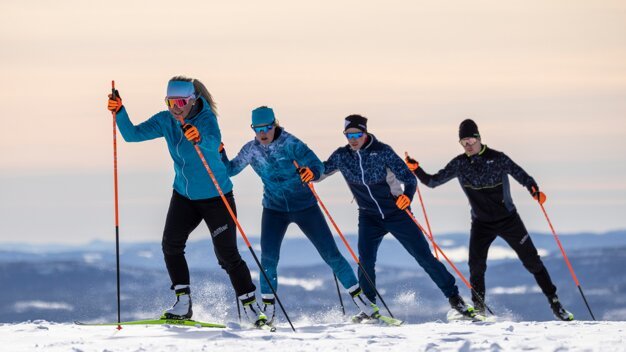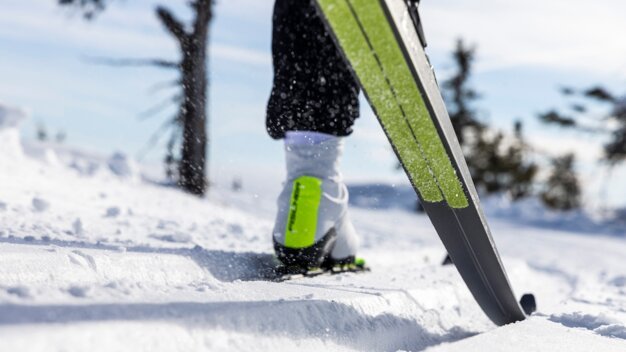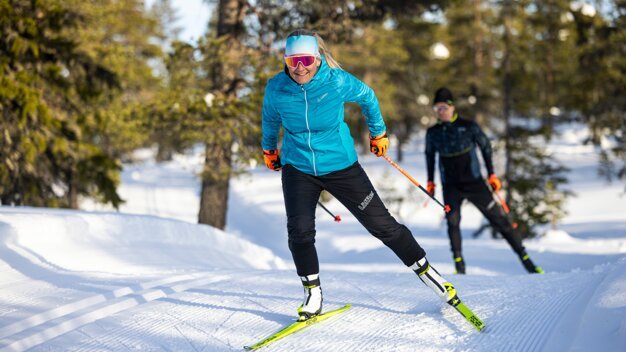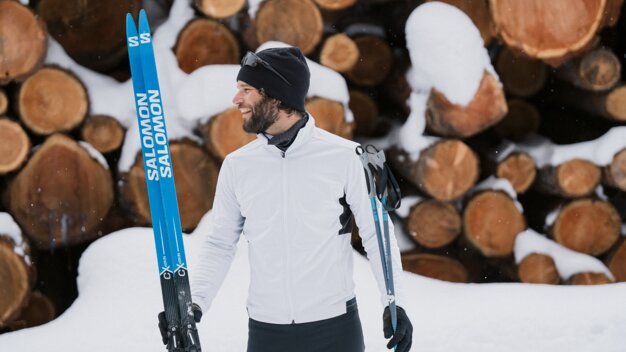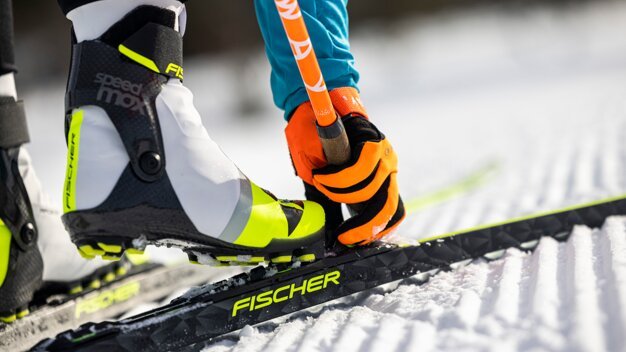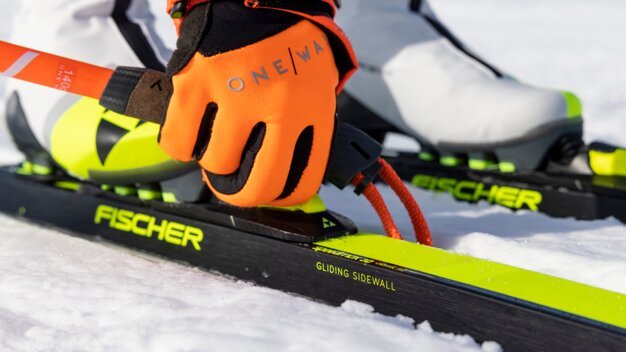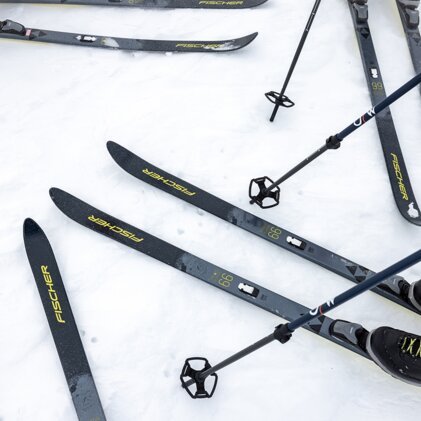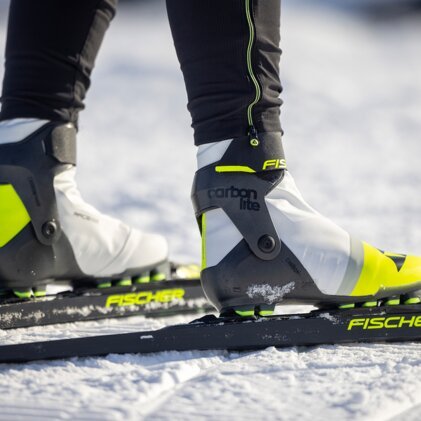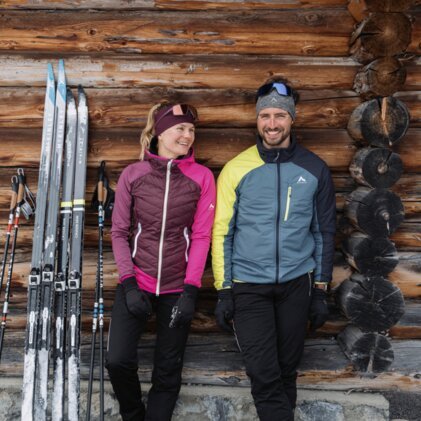
Snow glistens all around you. The sun is shining and it's your day off. You've decided to try a new sport and are looking for the right cross-country skiing equipment? Our experts have put together a checklist of the right things and answer the most important questions for your first laps on the trail below.
The right cross-country skis
Choosing the right skis is crucial for fun and success on the trail. Unlike alpine skis, which are designed for speed and stability on the slopes, cross-country skis are very light, narrow and flexible – ideal for smooth movements on designated trails. It is particularly important to note that they are available in different versions, which are tailored to different styles.
As a general rule, unlike alpine skis, cross-country skis …
- ... are narrower.
- ... weigh less.
- ... have only a slight sidecut.
- ... have a relatively high camber.
- ... are designed for gliding.
Two cross-country skiing techniques
There are two different styles: classic and skating. While the classic one is more reminiscent of walking in terms of its movements, skating is more similar to ice skating.
In order to execute the techniques of both styles correctly, cross-country skis differ in important ways.
Special features of cross-country skis: classic style
- Base: have a climbing zone in the middle and a gliding zone in front and behind
- Shape: have a wider ski tip than skating skis
- Length: generally longer
- Stiffness: softer and more flexible
Good to know: Classic skis are available as wax skis or no-wax skis. No-wax models are also called scale or skin skis because they have an integrated climbing aid (made of scales or skin) that does not require climbing wax maintenance. They are a good choice for beginners because they require less maintenance. Experienced skiers with solid technique and a desire for maximum performance, on the other hand, rely on wax skis.
Special features of cross-country skis: skating style
- Base: have a continuous gliding zone and no climbing zone
- Length: shorter than skis for classic style
- Stiffness: they are harder and more difficult to twist
Our tip: Once you have chosen your style of skiing, the right length depends primarily on your weight and height. The following rule of thumb provides a rough guide:
- Classic skis: body height plus 20 to 30 centimetres
- Skating skis: body height plus 10 to 15 centimetres
If you cannot decide between two sizes, beginners should opt for the shorter model. This will give you better control and prevent you from going too fast. For more information on the right length for your cross-country skis, you can also visit our experts at an INTERSPORT Rent shop near you at any time. We look forward to seeing you.
The right cross-country boots
First, the good news: cross-country skiing boots are much more comfortable than alpine models. Despite the added comfort, there are a few things to consider when choosing them. To get started on the trails, you will also need special boots. The requirements depend on the style. There are models for classic style as well as for skating. Let's take a look at the differences:
Features of boots for classic style:
- Lower shaft than skating boots
- Softer sole construction
- More freedom of movement
- Mostly lace-up
Special features of skating shoes:
- High shaft (above the ankle)
- Harder sole
- High stability
- Lace-up or buckle fastening
Combination shoes:
- Suitable for classic and skate
- Medium-hard sole
- With removable shaft or shaft clip
- Must fit the binding system
Just like in alpine skiing, boots play an important role in cross-country sports. After all, we know that blisters on your feet can end your day prematurely. Your cross-country boots should therefore fit perfectly to ensure good power transmission. Because every foot is unique, there are models that can be customised with a boot fitting. Various processes are used to create a boot that fits your foot perfectly.
Our tip: Make sure they are compatible with your bindings! If you are unsure, our RENTertainers will be happy to advise you on the common standards for this nordic sports.
Choosing the right cross-country ski poles
Another important part of your equipment is the right cross-country ski poles. In most cases, these are made of aluminium, carbon or a carbon mix. Each material has its advantages and disadvantages in this context. Aluminium poles are solid and inexpensive, but slightly heavier. Carbon models, on the other hand, are the lightest and offer very good power transmission. However, unlike aluminum, they are more prone to cracking and are comparatively more expensive to purchase.
The right length is crucial for transferring power to the trail in a way that benefits your performance. It should be tailored to your technique, weight and height.
Pole length for classic skiing:
- Guideline: The top of the pole should reach approximately to your shoulder.
- Formula: Body height in centimetres x 0.83 to 0.85
Pole length for skating:
- Guideline: The top of the pole should be approximately between your chin and the tip of your nose.
- Formula: Body height in centimetres x 0.89 to 0.9
Beginners in particular should opt for shorter models at first, as these will help them learn the correct technique. There are also height-adjustable poles that can be used for both classic and skating.
The right cross-country skiing clothing
Although this sport looks very easy, you can work up quite a sweat, especially when going uphill. That's why it's important that your cross-country skiing clothing is breathable. It also needs to offer good protection against snow and cold.
So what's the best solution? Exactly: the onion principle. This allows you to add or remove individual layers as you wish.
For a good cross-country skiing outfit, you need:
Base layer: the layer closest to your skin
- Functional underwear made of synthetic fibres, merino wool or a material mix
- Should wick sweat away from your skin quickly
Mid-layer: as warm as necessary
- Fleece shirt or a lined vest
- Designed to retain body heat
Hard shell: defy the weather
- A membrane that keeps wind and weather out while allowing water vapour to escape.
- Protects you from the elements
Our tip: Practical accessories complete your outfit. Hats, gloves, tube scarves and ski goggles ensure maximum comfort on the trail.
The right accessories for your cross-country skiing equipment
If you are taking up a new hobby and want to use your gear for a long time, proper care is essential. It ensures a high level of comfort even after repeated use and guarantees that you will be able to enjoy the same performance even after years of use. Below you find a selection of products:
- Detergent for functional clothing
- A fine brush to remove snow residue after a day on the trail and keep your skis dry
- A cloth for drying skis, bindings and boots
- Waterproofing spray for textiles (there are also waterproofing agents that can be washed in)
- Depending on the skis, universal or quick base waxes
If you have any questions about the right products, the RENTertainers are here to help. Visit one of our 800 shops worldwide. We are looking forward to your visit.
Frequently asked questions about cross-country skiing equipment
Do you wear a helmet for cross-country skiing?
There is no general requirement to wear a helmet. Even so, wearing head protection is not uncommon. Hats or headbands are usually worn, as the speed of cross-country skiing is relatively low. However, wearing a helmet may be advisable on steeper trails. Special, well-ventilated models are available for this purpose.
What trousers should I wear for cross-country skiing?
Special cross-country skiing trousers can be worn. These close-fitting models are usually made of synthetic fibres (polyester, elastane, etc.) to ensure maximum freedom of movement. In addition, these models are often windproof and water-repellent.
What kind of underwear should I wear for cross-country skiing?
The layer of clothing closest to the skin when cross-country skiing should consist of functional underwear. The so-called base layer absorbs moisture from the skin and transfers it to the layers above, thus preventing the body from cooling down.
What kind of shoes do I need for cross-country skiing?
The shoes for cross-country skiing you need depend primarily on your skiing style. In addition to models for the classic style, there are skating and combination shoes. Also make sure that they fit the binding system.
Intersport Rent tip
The RENTertainer recommends
Especially when you're just starting out with a new sport, you don't want to spend a fortune only to find out that your new hobby isn't for you. INTERSPORT Rent's ski rental service allows you to test the gear in advance. This gives you a first idea for what you need and which products are right for you.
You can also get advice on site from our experts. They will give you useful tips on the products and know the area like the back of their hand. You're sure to pick up a few insider tips here too.
Related articles
You may also be interested in:
